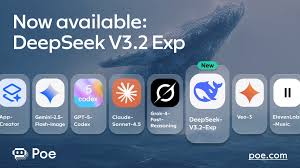Chinese AI startup DeepSeek has launched the DeepSeek V3.2 experimental model, an advanced iteration of its DeepSeek-V3.1-Terminus architecture, reigniting global interest in its mission to deliver high-performance artificial intelligence at dramatically reduced cost and computational demand. Unveiled via a post on Hugging Face, the experimental release builds on the company’s growing reputation for efficiency-driven innovation—just one year after its surprise debut with the R1 model shook Silicon Valley and challenged assumptions about how large language models (LLMs) are trained and deployed.
The new model introduces a core advancement: DSA (DeepSeek Sparse Attention), a mechanism designed to significantly improve how AI processes long-form documents and extended conversations by focusing only on the most relevant data points. Unlike traditional attention systems that analyze every piece of input data regardless of relevance, sparse attention filters out less critical information—reducing processing load, cutting energy consumption, and lowering operational costs. According to Adina Yakefu, Chinese community lead at Hugging Face, this update halves the cost of running the model compared to its predecessor while maintaining performance levels, making it faster and more accessible for developers and organizations with limited resources.
Nick Patience, Vice President and Practice Lead for AI at The Futurum Group, described the development as significant. “This makes powerful AI more accessible to researchers, startups, and smaller enterprises,” he said. “Efficiency is becoming as important as raw power—and DeepSeek is proving that you don’t need the largest infrastructure to compete at the highest level.”
The principle behind sparse attention mirrors real-world decision-making: when plotting a flight path, airlines discard impractical routes early to save time and fuel. Similarly, the DeepSeek V3.2 experimental model aims to streamline AI inference by prioritizing contextually important inputs. This capability is especially valuable for applications involving legal documents, scientific research, enterprise reporting, and multi-turn dialogue systems where data volume can overwhelm standard models.
However, experts caution that the benefits come with trade-offs. Ekaterina Almasque, co-founder and managing partner at venture capital firm BlankPage Capital, raised concerns about reliability and transparency. “Sparse attention models have lost a lot of nuance,” she warned. “The critical question is not just whether they exclude unimportant data—but whether they’re accidentally discarding vital information.” Without clear oversight into how the model determines what to ignore, there is a risk of degraded output quality, particularly in sensitive domains like healthcare, law, or public policy.
Almasque also questioned the model’s safety and inclusivity, noting that biased filtering mechanisms could amplify existing gaps in representation or understanding across languages and cultures. While DeepSeek claims the experimental version performs on par with its earlier Terminus model, independent validation remains limited, and the lack of full documentation raises flags among some researchers.
Another point of debate centers on sustainability of competitive advantage. By releasing the programming code and tools openly, DeepSeek enables widespread learning and adaptation—a move praised for fostering open innovation. But Almasque noted that sparse attention is not a novel concept, having been discussed in AI research since at least 2015. Because the model is open source, DeepSeek cannot patent its implementation, meaning its edge lies not in exclusivity but in the sophistication of its selection logic.
Yakefu emphasized that the release reflects a broader strategy: positioning DeepSeek as a long-term player in the global AI race. “People will always go for what is cheap, reliable, and effective,” she said, adding that the model works seamlessly with China-made AI chips such as Huawei’s Ascend and Cambricon, enabling local deployment without reliance on Western hardware—an increasingly strategic advantage amid tightening U.S. export controls.
Despite the excitement, the company itself describes the DeepSeek V3.2 experimental model as an “intermediate step toward our next-generation architecture,” signaling that further developments are already underway. As geopolitical competition intensifies between the U.S. and China over AI leadership, breakthroughs like this underscore a shifting paradigm: where once scale dominated the conversation, efficiency, adaptability, and accessibility are now equally critical metrics of progress.
For now, the model stands as both a technical achievement and a provocation—one that invites collaboration, scrutiny, and caution in equal measure.
Follow us on Instagram.
https://www.instagram.com/businessnewsng?igsh=ZXpweTdjOGF1ZXdu

























